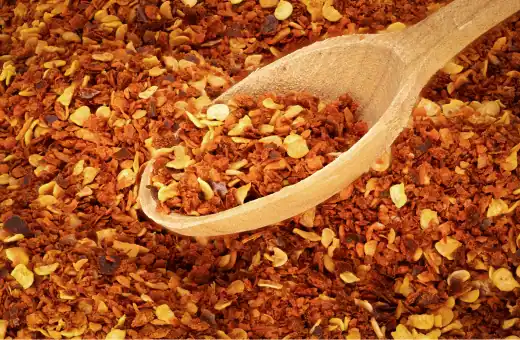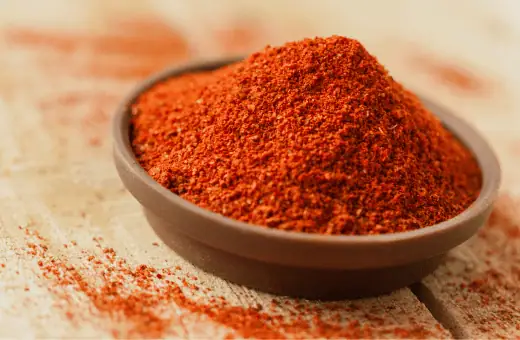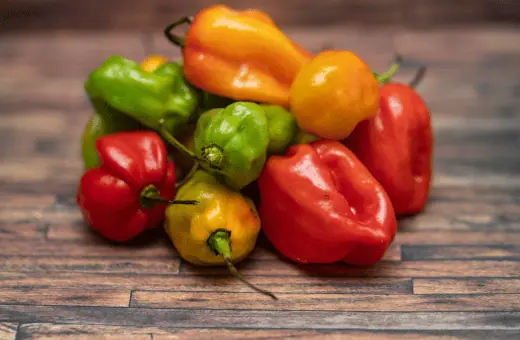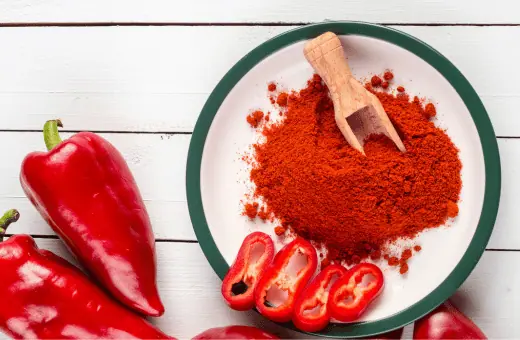As a professional chef and experienced cook, I know how important spices and herbs are in cooking.
They not only add flavor and aroma but also provide health benefits.
Thai peppers are a tiny but power-packed ingredient used in many authentic Thai recipes for their distinctive heat and spiciness.
But what if you can’t find Thai peppers in your local grocery store? Don’t worry; there are plenty of alternates you can use that are readily available.
In this blog post, I’ll share with you 8 of the best substitutes for Thai chili peppers, along with their measurements.
In short " What I Can use instead of Thai peppers?" Red Pepper Flakes, Serrano Peppers, Cayenne Pepper, Jalapeno Peppers, Crushed Black Pepper, Habanero Peppers, Anaheim Peppers, Paprika
What kind of peppers are Thai peppers and what do Thai peppers taste like?
Thai peppers, also known as Bird’s Eye Chili or prik kee noo, are small but fiery chili peppers that originated in Thailand.
They are parts of the Capsicum annuum species and measure between 50,000 – 100,000 Scoville Heat Units (SHU) on the Scoville scale.
As such, Thai peppers pack quite a punch – much more than jalapeños – ranging from mildly hot to very spicy. In terms of flavor and taste, Thai peppers have an intense heat combined with a sweet fruity flavor.
The kick is immediate and lingers for some time after consumption. If you are looking for more burst of heat in your dishes, Thai peppers can provide it!
Uses of Thai peppers
Thai peppers, or Thai chili peppers, are an integral part of Southeast Asian cooking. The tiny but potent fruits are used in various dishes to add spice and flavor.
A member of the capsicum family, Thai peppers can range from mild to intensely spicy, depending on the variety and amount used.
In Thailand, they are often eaten fresh or dried and pounded into a paste to make sauces, curries, salads, and other dishes.
In addition to adding flavor to food, Thai peppers have a number of medicinal benefits as well. They contain high levels of vitamins A and C as well as beta carotene which can help reduce inflammation and boost immunity.
Studies have also found that capsaicin compounds found in hot peppers can help fight cancer cells, reduce cholesterol levels, increase circulation, ease pain associated with arthritis, and even aid with weight loss by boosting metabolism.
An interesting way to incorporate Thai peppers into meals is to make them part of a stir-fry dish; the heat adds another layer of flavor that can’t be achieved with just vegetables alone.
They also work great for marinades or pickled recipes for a unique twist on traditional dishes.
Finally because they come in different varieties ranging from mild to super hot there is something for everyone when it comes to using Thai peppers in their kitchen!
Where to buy thai Chili peppers?
If you’re looking for where to buy thai chili peppers, there are a few different places you can go. Many specialty food stores carry it, as do some international grocery stores.
You can also order online from many retailers that provide a variety of diverse flavors and types of Thai chili peppers.
Best substitute for Thai chili peppers
1. Red Pepper Flakes

Red pepper flakes are one of the most common substitutes for Thai peppers. They are made from dried and crushed chilies and have a milder heat, but a similar flavor profile to Thai peppers.
Use as in any recipe that calls for Thai peppers, but use them sparingly at first, as they can still pack a good amount of heat.
Ratio or measurement: The general rule of thumb is to use ½ to 1 teaspoon of red pepper flakes for every Thai pepper.
2. Serrano Peppers
If you’re looking for a alternative that has a similar heat level to Thai peppers, consider using Serrano peppers. They are small, thin, and often green in color.
Serrano peppers have a crisp and bright flavor that is perfect for cutting through the richness of dishes like curries or stir-fries.
Ratio or measurement: Use one Serrano pepper for every Thai pepper called for in the recipe.
3. Cayenne Pepper

You can try this one as well. Like red pepper flakes, cayenne pepper is made from dried and ground chilies.
It has a slightly hotter heat level than Thai peppers, but a similar bright and peppery flavor.
Ratio or measurement: Use ¼ to ½ teaspoon of cayenne pepper for every Thai pepper.
4. Jalapeno Peppers
Jalapeno peppers are another common substitute for Thai peppers. They are a bit less spicy but still have a good amount of heat.
They also have a distinct green pepper flavor that pairs well with many Thai dishes.
Ratio or measurement: Use one or two jalapeno peppers for every Thai pepper.
5. Crushed Black Pepper
If you’re in a pinch and can’t find any of the above substitutes, crushed black pepper is a good option.
While it doesn’t have the same level of heat or flavor profile as Thai peppers, it can add a nice kick to your dish.
Ratio or measurement: Use 1 to 2 teaspoons of crushed black pepper for every Thai pepper.
6. Habanero Peppers

If you are a fan of spicier food, Habanero peppers are an excellent substitute for Thai peppers. Since they are one of the spicier pepper varieties, you should use them sparingly.
Ratio or measurement: One habanero is usually enough to replace several Thai peppers in a recipe.
Be cautious not to add too much heat to the dish and overpower the other flavors.
7. Anaheim Peppers
Anaheim peppers are an excellent substitute for Thai peppers because they have a mild heat level and a slightly sweet flavor.
They are perfect for dishes that require a subtle kick of heat or a sweeter flavor, such as Thai stir-fries, salads, and soups.
Ratio or measurement: Depending on the recipe, you can use one or two Anaheim peppers to replace one Thai pepper.
8. Paprika

Paprika is a mild spice with a sweet flavor that makes it an excellent substitute for Thai peppers. It is perfect if you want to add a smoky flavor to your dish without too much heat.
Ratio or measurement: For every one small Thai pepper, use 1 teaspoon of paprika.
Explore more: Top trending Padron peppers substitutes
Dried thai chili substitute
There are several great substitutes for dried thai chili peppers that can be used to give a dish the same flavor and heat.
1. Cayenne Peppers
These bold and spicy chilies are closely related to the Thai pepper, and they offer a similar flavor profile with an equal level of heat.
To use cayenne pepper as a substitute it’s best to use approximately 1 teaspoon of cayenne pepper powder per each dried Thai chili called for in the recipe or adjust according to your desired spiciness level requirement.
They can be found in most supermarkets in powder, flakes, or whole form.
2. Hot Paprika
A common spice cupboard staple, hot paprika is made from dried red pepper pods that have been finely ground into a powder.
It gives dishes a smoky sweetness balanced out by a fiery kick thanks to its moderate level of heat.
3. Arbol Chilies
These long and skinny chilies feature bright red skin and intense heat with nutty undertones.
Though these chilies may not be as easy to find in grocery stores, specialty spice shops often carry them for those who wish to venture down this path when looking for a substitute for dried Thai chili peppers.
4. Serrano Peppers
This popular chili pepper has a tingly heat with herbal undertones that help deliver plenty of flavor to your dish along with its medium-high level of spiciness that’s comparable to the Thai variety.
When fresh, these can be found in most grocery stores but if you’d prefer them dried you can typically find those at Mexican markets or online retailers as well.
5. Aleppo Chilies
These versatile little chilies offer beautiful color to dishes along with their mild-medium level of spiciness that consists of fruity notes beneath their pleasantly warm kick.
Making it an ideal substitute for those seeking a sweet yet savory version of the traditional Thai chili pepper without sacrificing too much on the heat scale!
You’ll find these widely available in most grocery stores as well as online retailers in both flake and powder form.
To effectively replicate usage rates related to typical standard amounts required when using traditional “Thai” chillies; then roughly 2 teaspoons worth should suffice per each single call-out request when required .
6. Red Pepper Flakes
Made from crushing up dry-roasted red pepper flakes; this variety of crushed red peppers can be used as a great alternative when needing a milder version of dried Thai chilies either in sauces or dishes alike.
If you do not have access to fresh or reconstituted versions at hand but still require that flavor profile combination associated with red chilis instead of other alternatives such as green bell peppers.
Which would not normally provide that same element of heat desired from such dishes involving Mexican-style cuisine, Indian curries or Asian stir-fry recipes etc…
To use these flakes effectively you should use one tablespoon per every single dried Thai chili called for in your recipe.
But again this may need adjusting according to individual tastes/preference requirements regarding overall heat levels involved once completed wares have been created & consumed
7. Smoked Paprika Powder
Lastly we have smoked paprika powder which has become increasingly popular over recent years due its subtle complexities related flavor profiles combined with mildly elevated spice “heat” elements present within its composition.
Making it ideal candidate choice when needing major adjustments done regarding overall taste profiles inherent within certain recipes whilst still requiring some form additional “spice” element provided by chilli sources alike.
Even though typically much lower intensity levels are present compared against far hotter alternatives listed above iIn order get good results via this method.
Then its highly advisable that 1 teaspoon worth smoked paprika powder should be added per every single dried Thailand chilli requested within recipe parameters itself.
So therefore adjustment ratios remain relatively consistent throughout entire process.
Learn more: Trending substitute for shishito peppers
Habanero vs thai chili- whats the difference?
Habanero chilis and Thai chilis are two of the most pungent types of chili peppers, having an intensely spicy flavor that can significantly enhance any dish. While they are both very spicy, there are some differences between them.
Habanero chilis originate from Mexico and Central America, where they have been cultivated for centuries.
They vary in color from yellow to orange, and measure around 1-2 inches in length. Habaneros generally have a bright, citrusy flavor profile, with a sharp heat that packs a punch.
Thai chilis, on the other hand, come from Southeast Asia (they are especially popular in Thailand). They tend to be red or green in color and measure anywhere from 3 inches long to less than one inch.
Unlike habaneros, Thai chilis have more of a fiery heat that is not as sweet.
In terms of spiciness level, habaneros are much hotter than Thai chilis – up to 100 times hotter! This makes them perfect for adding an extra kick to dishes like salsas or sauces.
On the other hand, Thai chilis can still add plenty of spice without being overwhelming for those who may not enjoy overly hot foods.
In terms of culinary use, habaneros and Thai chilis are both commonly dried and ground into a powder for flavoring dishes. They can also be used in fresh form, added to soups, curries, sauces and more.
As with any chili pepper, it’s important to exercise caution when handling them – especially if you’re not accustomed to their heat!
Overall, habanero chilis and Thai chilis are two of the spiciest types of chili peppers around. While they share more similarities, there are some distinct differences between them that make each one unique.
Whether you prefer a sharp citrusy flavor or a fiery heat, these two peppers can add an extra kick to a variety of dishes.
In conclusion, habanero chilis and Thai chilis are two very different types of chili peppers that can be used to add spice and flavor to many dishes.
While they are both incredibly pungent, their distinct flavors make them ideal for adding unique touches to any culinary creation.
Know more: Quick Chile de Arbol Substitutes
Conclusion on substitute for Thai chili peppers
After reading this blog, you now have a list of the best substitutes for Thai peppers that you can use in your cooking.
Whether you prefer a mild or spicy flavor, these alternatives are perfect to spice up your dishes without being too overpowering.
Always remember to use the substitutes in small amounts to get the perfect heat level. Try these substitutes today and let us know which ones worked best for you!
FAQs on substitute for Thai chili peppers
Q1. What is similar to Thai peppers?
Thai peppers are similar to other chili peppers, such as jalapeños, serranos, and habaneros. They have a bright, spicy flavor that adds heat to dishes without being overly hot. Unlike some of their spicier counterparts, Thai peppers have a milder taste and fruity aroma that make them popular in many dishes.
Their vibrant color also makes them an attractive garnish or addition to salads and stir-fries. In Thailand, they are often pickled and served with seafood dishes or eaten raw by themselves.
Despite their relatively mild heat level compared to other chilies, it is still important to wear gloves when handling Thai peppers as their capsaicin oils can cause skin irritation if not handled properly.
Q2. Can I substitute Thai chili for jalapeno?
Yes, you can substitute Thai chili for jalapeno in many recipes. Depending on the recipe, Thai chili peppers may have a slightly spicier flavor than jalapenos, so adjust the amount of chili used accordingly.
Additionally, you should be aware that Thai chilis are usually slimmer and smaller than jalapenos, so if a recipe calls for a specific number of peppers to be used, you may need to use more Thai chilis than the number of jalapenos called for in order to get the same amount of flavor.
Q3. Are Thai chilis the same as serrano peppers?
No, Thai chilis and serrano peppers are not the same. Thai chilis are native to Southeast Asia, while serrano peppers are native to Mexico. In terms of heat level, Thai chilis range from 50,000 to 100,000 Scoville Heat Units (SHU), while serrano peppers range from 10,000 to 23,000 SHU on the Scoville Scale.
This makes Thai chilies significantly hotter than serrano peppers. Additionally, Thai chilies are typically thin and pointed in shape with a bright red color when ripe, while serrano peppers tend to be thicker and have a shiny green or red color when ripe.
Although they both share an intense spiciness that can add flavor to many dishes, these two chili varieties are distinct in terms of their origins and heat levels.
Q4. Can i substitute jalapeno for thai chili pepper?
Yes, you can substitute jalapeno peppers for Thai chili peppers. However, the flavor of your dish may be different because jalapenos are spicier than Thai chili peppers. Keep in mind that when substituting ingredients, it is best to adjust amounts as necessary to achieve the desired flavor profile.
Additionally, if you want a milder heat level in your dish but still want some kick, consider reducing the amount used or seed and de-vein the jalapeños before adding them to your recipe. This will help reduce the overall spiciness while still providing some heat and flavor.
Q5. How much cayenne equals thai chili?
Cayenne and Thai chilis are both members of the Capsicum annuum species, but their flavor and heat levels differ significantly. Cayenne peppers have a moderate to hot level of spice, measuring 30,000 – 50,000 Scoville Heat Units (SHU). In comparison, Thai chilis rank much higher on the Scoville scale, with an average of 50,000 – 100,000 SHU.
The two peppers also vary in taste: cayenne peppers are generally more earthy and herbal in flavor compared to the bright spiciness of Thai chilis. While they may be utilized interchangeably in some recipes due to their similar heat levels, they cannot be considered equal substitutes as the overall flavors created will be different.
Q6. What can i use instead of thai spice?
Instead of Thai spice, you can use a combination of ingredients that will give you similar flavor and aroma. These include lemongrass (which has an earthy citrus scent), galangal (which is slightly peppery with a hint of ginger-like aroma), and kaffir lime leaves (which have a sharp citric aroma).
You can also add some heat with chili peppers or chili powder. To round out the flavor, you can mix in garlic, shallots, onion, tamarind paste, and fish sauce. Additionally, coriander seeds and cumin are great for adding an earthy undertone to dishes. Each of these ingredients bring a unique flavor that combines to form the familiar Thai spices we know and love.
Q7. Substitute for nora peppers
1. Jalapeno Peppers: These fiery peppers have a similar level of heat as nora peppers, with a slightly earthier taste. They are also more widely available than nora peppers, making them an ideal substitute for recipes that call for nora peppers.
2. Pasilla Peppers: The milder cousin of the nora pepper, pasilla peppers offer a flavor profile that is similar to that of nora peppers without the intense heat. These long-shaped dark green chiles have subtle smoky and raisin-like flavors that make them a great alternative to nora peppers in dishes like salsa and chili.
3. Poblano Peppers: Commonly found in Mexican cuisine, poblano peppers are a mild variety of pepper that can be used to replace the heat from nora peppers while still adding flavor to dishes. Although these peppers are not as hot as their spicy counterparts, they do contain notes of mild sweetness which makes them perfect for creating sauces and stuffing with cheese or other fillings.
4. Serrano Peppers: While slightly hotter than nora peppers, serrano peppers can bring some kick to recipes calling for the deep, smoky flavor of the milder nora pepper. These cylindrical shaped chiles are commonly used in salsas and other Mexican dishes and can easily be substituted in any dish requiring nora pepper heat and flavor.
5. Ancho Peppers: Ancho peppers have a sweet and smoky flavor with just a hint of spice when compared to its close relatives–the jalapeno or serrano pepper–making it an ideal choice as a substitute for nora peppers in many recipes. These dried chiles provide great depth of flavor to Mexican dishes such as enchiladas and tamales without overpowering the other ingredients in the dish.

